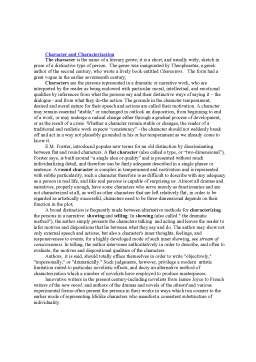Extras din proiect
Author and Authorship
Authors are individuals who, by their intellectual and immaginative powers, purposefully create from the materials of their experience and reading a literary work which is distinctively their own,
The work itself, as distinct from the individual written or printed texts that satiate the work, remains solely a product accredited to the author as its originator, even if he or she turns over the rights to publish and profit from the printed texts of the work to someone else. And so far as the literary work turns out to be great and original, the author who has composed that work is deservedly accorded high cultural status and achieves enduring fame.
The author is said to be the product rather than the producer of a text, and is often redescribed as an "effect" or "function” engendered by the internal play of textual language. historicists conceive authorship to be a "cultural construct" that emerged and changed, in accordance with changing economic conditions, social circumstances, and institutional arrangements, over many centuries in the Western world.
Investigators have emphasized the important role of such his torical developments as:
• The shift from an oral to a literate culture.
• The shift, in the course of the fifteenth and sixteenth centuries, from a primarily manuscript culture to a primarily print culture.
• The emphasis in recent research on the difficulties in establishing, in various periods, just who was the originator of what parts of an existing literary text, which was often, in effect, the product of multiple collaborators, censors, editors, printers, and publishers, as well as of successive revisions by the reputed author.
• The proliferation of the population of middle-class readers in the late seventeenth and eighteenth centuries, and the attendant explosion in the number of literary titles printed, and in the number of writers required to supply this market.
Historicist scholars of authorship have clearly demonstrated that there has been a sustained interplay between the economic circumstances and institutional arrangements for producing and marketing literary texts and the detailed way that the authorship of such texts has been conceived. The radical further claim, however, that the modern figure and functions assigned to an author are in their essentials a recent formation, resulting from the distinctive conditions of the literary marketplace after the seventeenth century, does not jibe with a great deal of historical evidence. A competent literary author - Horace refers to him variously as scriptor(writer), poeta (maker), and carminis auctor (originator of a poem)-must possess a natural talent or genius (ingenium) as well as an acquired art, and purposefully designs and orders his poema in such a way as to evoke the emotions of his audience. And if a published work succeeds in instructing and giving pleasure to a great many readers, it is a book that not only "makes money for the bookseller," but also "crosses the sea and spreads to a distant age the fame of its author." Clearly, Horace distinguishes between material and authorial; or intellectual, ownership, in that the author, even if he has no proprietary interest in a published book, retains the sole responsibility and credit for having accomplished the work that the text of the book incorporates.
Ballad
A short definition of the popular ballad (known also as the folk ballad or traditional ballad is that it is a song, transmitted orally, which tells a stoy. Ballads are thus the narrative species of folk songs, which originate, and are communicated orally, among illiterate or only partly literate people. In all probability the initial version of a ballad was composed, by a single author, but he or she is unknown; and since each singer who learns and repeats an oral ballad is apt to introduce changes in both the text and the tune, it exists in many variant forms. Typically, the popular ballad is dramatic, condensed and impersonal: the narrator begins with the climactic episode, tells the story tersely by means of action and dialogue (sometimes by means of the dialogue alone), and tells it without self-reference or the expression of personal attitudes or feelings.
The most common stanza form-called the ballad stanza-is a quatrain in alternate-four- and three-stress lines; usually only the second and fourth lines rhyme. The conventionally abrupt opening and the manner of proceeding by third-person narration, curtly sketched setting and action, sharp transition and spare dialogue.
Many ballads employ set formulas (which helped the singer remember the course of the song) including :
• stock descriptive phrases
• a refrain in each stanza
• incremental repetition, in which a line or stanza is repeated, but with an addition that advances the story
Although many traditional ballads probably originated in the later Middle Ages, they were not collected and printed until the eighteenth century, first in England, then in Germany.
A broadside ballad is a ballad that was printed on one side of a single sheet (called a "broadside"), dealt with a current event or person or issue and was sung to a well-known tune. Beginning with the sixteenth century these broadsides were hawked in the streets or at country fairs in Great Britain.
The traditional ballad has greatly influenced the form and style of lyric poetry in general. It has also engendered the literary ballad, which is a narrative poem written in deliberate imitation of the form, language and spirit of the traditional ballad. In Germany, some major literary ballads were written in the latter eighteenth century. Lyrical Ballads, are ballads which are opening with the abrupt and impersonal third-person narration of the traditional ballad.
Preview document
Conținut arhivă zip
- Fise Termeni Literari.doc
































